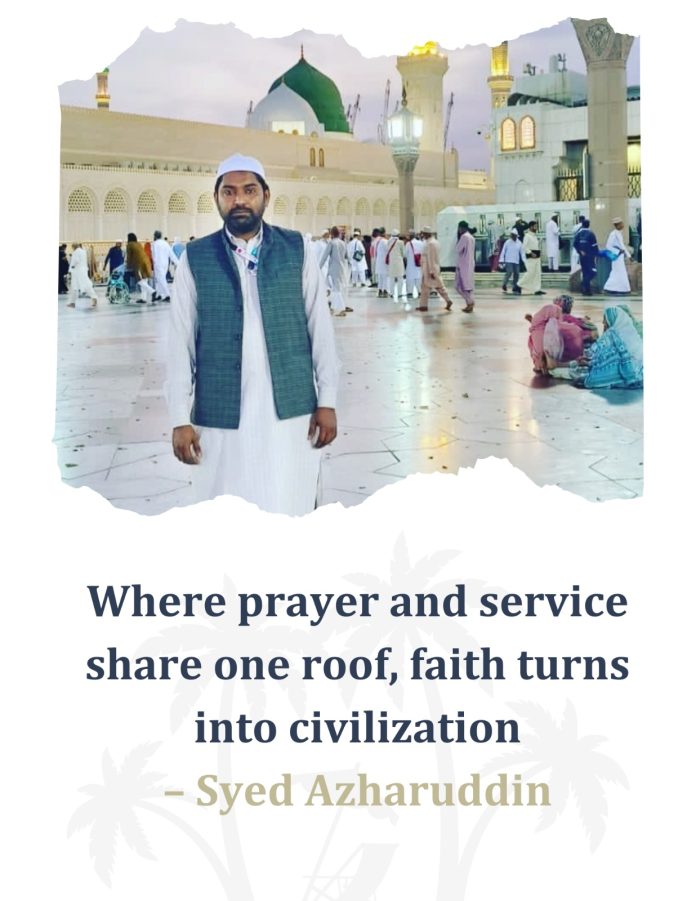– Syed Azharuddin
When the Prophet Muḥammad ﷺ arrived in Yathrib – soon to be known as al-Madinah al-Munawwarah – in 622CE, his first public act was neither to build a palace nor to secure a fortress. He purchased a modest plot of land from two orphan brothers, Sahl and Suhayl, and laid the foundation of al-Masjid an-Nabawi, the Prophet Muḥammad’s ﷺ Mosque. This decision revealed a profound truth: for Islam, the mosque is not a peripheral house of worship but the very heart of civilization.
The Qur’ān states, “The mosques of Allah shall be maintained only by those who believe in Allah and the Last Day, establish prayer, give zakāh and fear none but Allah” (Q 9:18).
Ḥadīth echoes this vision: “Whoever builds a mosque for Allah, Allah will build for him a house in Paradise” (Ṣaḥīḥ al-Bukhārī 450; Ṣaḥīḥ Muslim 533). From its earliest days, the Prophet’s Mosque embodied this mandate, becoming a centre of worship, governance, education, social welfare, and culture.
Architecture: Form Serving Function
The original structure was strikingly simple: an open rectangular enclosure of mud-brick walls, palm-trunk columns, and a roof of palm leaves. Three gates – Bab al-Raḥmah, Bab Jibrīl, and Bab al-Nisāʾ – ensured free movement. At one side stood the shaded Suffah, a platform for the poor and for students of knowledge.
The Prophet Muḥammad ﷺ personally carried bricks, reciting, “O Allah, there is no good except the good of the Hereafter, so forgive the Ansar and the Muhajirun.” (Ibn Hishām, Sīrah)
This plain architecture concealed profound lessons that modern planners continue to study (Spahic Omer, Form and Function of the Prophet’s Mosque, IIUM, 2016):
- Function–form unity: each addition – the minbar (pulpit), shaded porticoes, quarters for the Prophet’s family – answered a real community need.
- Environmental respect and cleanliness: natural ventilation and the Prophet Muḥammad’s ﷺ insistence on purity (“Cleanliness is half of faith,” Ṣaḥīḥ Muslim 223) prefigure today’s sustainability ideals.
- Promotion of just social interaction: the open courtyard, with no elevated dais for elites, visually expressed equality.
- Balance of indigenous and universal: local materials served a global faith, a template for mosques in every climate and culture.
Spiritual Core and Inclusive Worship
Five daily prayers, Friday congregations, Qur’ān recitation, and spiritual retreats (iʿtikāf) anchored the community’s rhythm. Prayer in this mosque yields immense reward – “One prayer in my mosque is better than a thousand elsewhere, except the Sacred Mosque” (Ṣaḥīḥ Bukhārī 1115). Women participated fully. The Prophet Muḥammad ﷺ said, “Do not prevent the female servants of Allah from the mosques of Allah” (Ṣaḥīḥ Bukhārī 824), and even allocated separate entrances and dedicated teaching sessions (Ṣaḥīḥ Muslim 649). The early Madinan mosque thus modelled gender-inclusive spirituality long before such language existed.
University of Faith and Knowledge
Revelation demanded literacy. The very first Qur’ānic command was “Iqraʾ – Read!” (Q 96:1). The mosque became Islam’s first university. Study circles convened daily; young companions such as Ibn ʿAbbās and Abū Hurayrah memorised ḥadīth and legal rulings. The Ashāb al-Suffah, a group of poor but devoted students living within the mosque, later served as judges, teachers, and governors across the expanding Muslim world. Women, too, pursued scholarship. ʿĀʾishah (RA) became one of Islam’s greatest jurists, and the Prophet regularly held exclusive teaching sessions for women. (Ṣaḥīḥ Bukhārī 101)
Government House and Court of Justice
The Prophet Muḥammad’s ﷺ Mosque doubled as the seat of the nascent Islamic state. It hosted shūrā (consultative) meetings on public policy, treaties, and security. Delegations from tribes and foreign rulers were received here, including the celebrated Christian envoys from Najrān, who were even permitted to pray in the mosque according to their own rites. (Ibn Kathīr, al-Bidāya wa’l-Nihāya)
Legal disputes – from business contracts to family conflicts – were adjudicated here. The Prophet Muḥammad ﷺ ruled impartially, sometimes against Muslims in favour of Jews or pagans, declaring, “Whoever cheats is not of us.” (Ṣaḥīḥ Muslim 102) Thus, the mosque functioned as a public courthouse embodying Qur’ānic justice: “If you judge between people, judge with equity.” (Q 4:58)
Welfare Hub and Bayt al-Māl
Charity and spirituality were never separate. Alms (zakāh) and voluntary donations (ṣadaqah) were collected and distributed directly from the mosque. (Ṣaḥīḥ Bukhārī 413) The Suffah sheltered homeless migrants; travellers and the poor were routinely fed there. This nucleus became the prototype of the Bayt al-Māl, the public treasury that financed education, healthcare, and defence. Guest accommodations attached to the mosque ensured travellers were cared for, reinforcing Islamic ethics of compassion and civic responsibility.
Medical Care and Humanitarian Relief
During battles such as Khandaq, tents for the wounded – most famously that of Saʿd ibn Muʿādh – were pitched inside the mosque. Rufaida al-Aslamiyyah, often called the first Muslim nurse, and other women provided treatment and post-operative care (Ibn Saʿd, Ṭabaqāt). The mosque was therefore the earliest field hospital and clinic, merging faith with compassionate health services.
Detention and Moral Rehabilitation
The mosque occasionally served as a secure but humane detention centre. Typical was the case of Thumāmah ibn Uthāl, tied to a pillar for several days. Observing Muslim worship transformed his heart; he accepted Islam and later became a key ally. (Ṣaḥīḥ Bukhārī 451) This illustrates rehabilitation over retribution, anticipating modern restorative-justice ideals.
Government, Law, and Military Preparation
Masjid-e-Nabawi functioned as the seat of the first Islamic government. Here treaties were signed, armies prepared, and legal cases adjudicated. Envoys – including a 60-member Christian delegation from Najrān – were hosted inside the mosque and even allowed to perform their prayers there. Military briefings preceded campaigns such as Badr and Uhud, and returning armies reported directly to the mosque, making it a hub of both diplomacy and defence.
Social Cohesion and Conflict Resolution
Tribal disputes, marital disagreements, and commercial conflicts were brought to the Prophet in the mosque for public arbitration. By combining spiritual authority with transparent process, the mosque fostered lasting reconciliation and social trust – an enduring model of participatory governance. The Prophet Muḥammad’s ﷺ Mosque functioned as an open court where personal and family disputes were resolved in full public view. In one incident, a man and his debtor came inside the mosque to settle a financial claim, and the Prophet Muḥammad ﷺ judged between them, instructing the creditor to show leniency toward the debtor. (Ṣaḥīḥ al-Bukhārī 7169, Kitāb al-Aḥkām)
In another well-known case, Ḥabībah bint Sahl sought the dissolution of her marriage from Thābit ibn Qays by presenting her request within the mosque, where the Muḥammad ﷺ mediated personally and facilitated an amicable khulaʿ. (Ṣaḥīḥ Muslim 1480; Sunan Abī Dāwūd 2217)
Leisure and Cultural Expression
The Prophet Muḥammad ﷺ encouraged wholesome recreation within the sacred space. On Eid, Ethiopians performed spear-dancing while the Prophet Muḥammad ﷺ and ʿĀʾishah watched. (Ṣaḥīḥ Bukhārī 445) Poets such as Ḥassān ibn Thābit recited verses defending Islam. (Ṣaḥīḥ Bukhārī 434) This shows that a vibrant community balances devotion with cultural joy.
Youth and Women Empowerment
Young companions such as Usāmah ibn Zayd were given command of military units while still in their teens. Boys like Ibn ʿAbbās were seated close to the Prophet Muḥammad ﷺ during sermons to absorb leadership skills. Women were entrusted with public welfare: Rufaida organised medical teams; Umm Waraqah was appointed to lead her household in prayer. (Abū Dāwūd 591) These examples make clear that the mosque was a training ground for leadership regardless of gender.
Lessons for Today’s Mosque Architecture
Drawing from Dr. Omer’s research and the Prophet’s practice, several enduring design principles emerge:
- Function–form relationship: prayer halls must integrate classrooms, clinics, multipurpose courtyards, and social spaces.
- Environmental respect and cleanliness: natural light, renewable energy, and water conservation echo the Prophetic stress on purity.
- Promotion of just social interactions: open courtyards encourage transparency and community dialogue.
- Indigenous yet universal: local materials and cultural motifs should harmonise with the mosque’s global spiritual mission.
Global Influence and Modern Relevance
From Cairo’s al-Azhar to Istanbul’s Süleymaniye, the template of a mosque as spiritual-civic complex comes directly from Madinah. Even today, Muslim communities seeking social renewal – whether in Kuala Lumpur, Lagos, or Chicago – find in al-Masjid an-Nabawi a timeless blueprint.
The Qur’ān affirms: “In houses which Allah has ordered to be raised…men and women remember Him morning and evening” (Q 24:36). Reviving the Madinan model means building mosques that are houses of God and houses of the people: places where prayer, education, welfare, justice, health care, and even wholesome leisure co-exist.
The Prophet Muḥammad’s ﷺ Mosque was never a mere architectural monument. It was – and remains – the ideal centre of community, weaving together worship and worldly responsibility. Within its wall’s faith met governance, learning met healing, and culture met compassion. Any society that revives this holistic vision can once again make the mosque the beating heart of a just, knowledgeable, and spiritually alive civilization.




